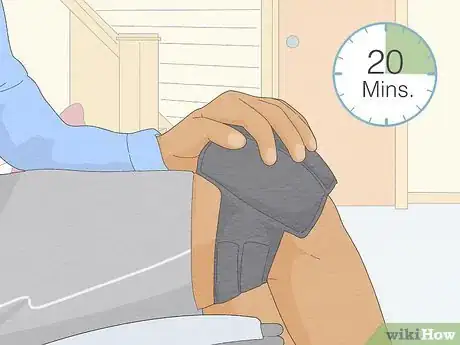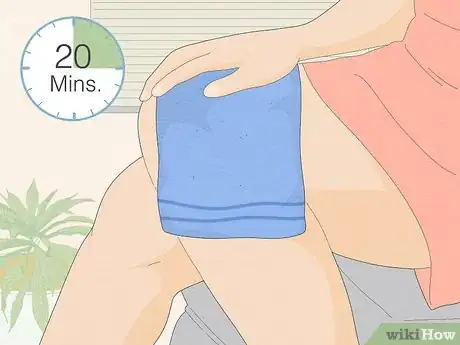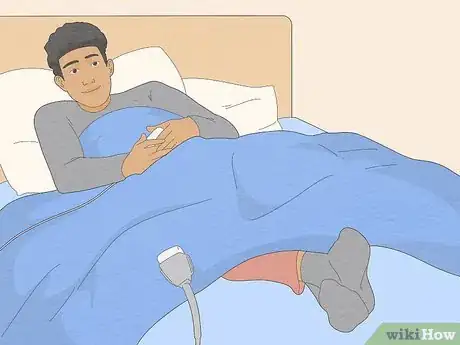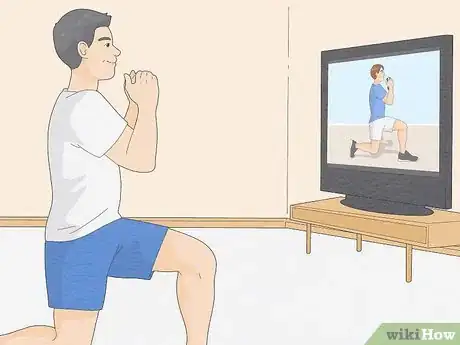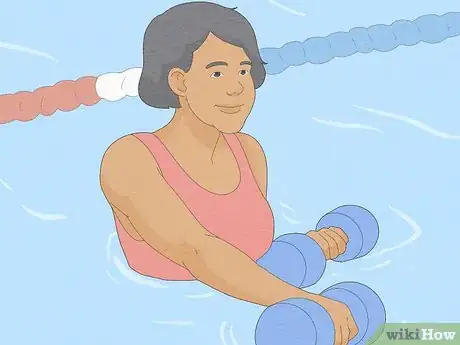This article was co-authored by wikiHow staff writer, Madeleine Criglow. Madeleine Criglow is a wikiHow Staff writer based in the Pacific Northwest. She has over six years of experience working in copywriting, editing, and journalism. In addition to her work for wikiHow, she writes a monthly film column for Tigard Life and Tualatin Life newspaper. Madeleine graduated from the University of Puget Sound with a BA in English with an emphasis in Creative Writing.
There are 11 references cited in this article, which can be found at the bottom of the page.
This article has been viewed 4,988 times.
Learn more...
If you find your knees getting especially cold and achy during winter, you are not alone! Cold temperatures can exacerbate symptoms of conditions like arthritis and other joint issues, leaving your knees feeling stiff or in pain. Even if the winter months don't cause your knees direct pain, cold temperatures can put a damper on your usual outdoor workout routine! Regardless of your exact situation, this article is here to help!
Steps
Warm up your knees with a heating pad.
-
Apply a heating pad to your knees for 20 minutes to provide direct warmth. Especially if your knees get achy when they are cold, this can be a great means to provide fast relief. Direct heat on your knees helps loosen up your muscles and even increases your circulation. If you have arthritis or find the winter months make your knees especially susceptible to aches and pains, try out this method for fast relief.[1] X Trustworthy Source Cleveland Clinic Educational website from one of the world's leading hospitals Go to source
- To avoid getting too hot or potentially injuring your skin, refrain from using the heating pad for longer than 20 minute periods.
Apply a warm washcloth to your knees.
-
If you don’t have a heating pad, a washcloth works just as well! Run a washcloth under hot water to warm it up. Next, wring out any extra water in the sink. Before applying it to your skin, make sure the washcloth is not too hot! Once it is the desired temperature, hold the washcloth against your knees for 20 minutes as you would a heating pad.[2] X Trustworthy Source Cleveland Clinic Educational website from one of the world's leading hospitals Go to source
Soak in a warm bath.
-
There's nothing like drawing a warm bath to relax your body! Relieve cold, aching joints by soaking in a warm bath for at least 20 minutes. The heat of the water eases stiff muscles, improving the range of motion in your knees and providing relief to any pain. Try this method out after a long day of walking outside in the cold or being stuck on your feet all day at work![3] X Trustworthy Source Cleveland Clinic Educational website from one of the world's leading hospitals Go to source
- If you prefer showers, a warm shower can provide similar benefits.
- Bundle up in layers right after your bath to keep your body feeling warm and cozy!
Invest in a mini space heater.
-
Keep a heater under your desk if your knees get cold! Whether stuck in a cold office all day or even just getting things done at home, you may find your knees getting cold even in the safety of the indoors. A space heater can make the room more toasty, and they come in a variety of models depending on the size and function you are looking for.[4] X Research source
- It's important to follow space heater safety guidelines. Always keep the heater at least 3 feet away from furniture, clothes, and thing like paper to avoid the risk of fire. Don't forget to turn it off when you're sleeping or out of the house![5] X Trustworthy Source Consumer Products Safety Commission Independent U.S. government agency responsible for protecting consumers by developing safety standards and conducting product research Go to source
Bundle up with an electric blanket to keep warm at night.
-
Use an electric blanket if layers of blankets just aren’t warm enough. Kind of like a heating pad in blanket form, an electric blanket uses electricity to heat up a soft, plush blanket so that you can be at your coziest! If your bedroom seems to stay cold at night no matter how high you turn up the thermostat, opt for an electric blanket. It will keep your body heat up throughout the night and provide instant relief to your knees.[6] X Research source
- Make sure you stay safe while using an electric blanket! Keep the wires of the blanket on the floor underneath the bed. Avoid storing them between your mattress and bed frame or box spring, and remember not to tuck in the blanket to avoid a potential fire hazard.[7] X Research source
Move your body to provide relief to cold, aching knees.
-
Staying mobile increases your range of motion and decreases joint pain. If cold winter temperatures are causing knee pain, or you just want to warm up your body, try out some simple exercises as a warm-up routine. If you're not feeling a full workout, even some simple stretches can do the trick.[8] X Trustworthy Source Harvard Medical School Harvard Medical School's Educational Site for the Public Go to source
- Start slow with stretches like a standing knee lift, a seated knee extension, or a standing hamstring curl.[9] X Trustworthy Source Harvard Medical School Harvard Medical School's Educational Site for the Public Go to source
Exercise indoors to avoid the cold.
-
Work out at a gym or at home to stay fit and warm at the same time! Websites like YouTube offer a variety of workout routines, from cardio to weight training. If you prefer working out with other people but can't justify running with your buddy in the cold, join a gym and consider taking an aerobics class or working with a personal trainer. [10] X Research source Each of these options keep your body warmed up, which increases the flexibility in your joints. If you find your knees getting stiff or achy in the cold, try out an indoor workout.
- If you don't know where to start, even a 20-minute dance session to your favorite album is a great workout routine! This one you can do from the comfort of your bedroom![11] X Research source
Work out in water.
-
Swimming and water aerobics in a warm pool are also great options. The combination of movement and warm water helps loosen your muscles, strengthens your joints, and can provide great relief to aching knees. If you want to stay warm while you exercise but don't feel like working out at home, consider joining a gym with a pool or taking a water aerobics class.[12] X Trustworthy Source Cleveland Clinic Educational website from one of the world's leading hospitals Go to source
Wear knee warmers when you exercise outside!
-
These are tight, tube-like pieces of clothing that wrap around your knees. Due to their ability to keep you warm and prevent injury, they are great choices for outdoor athletes in the winter months. If you often bike to work even during the coldest days of the year, consider investing in a pair of knee warmers to keep your knees from freezing. [13] X Research source
- Knee warmers come in a variety of styles, from spandex to fleece.
Talk to your doctor if you frequently experience knee pain.
-
Knee pain in cold weather may be related to an underlying condition. You may have experienced an injury, like torn cartilage or a ruptured ligament. Other conditions that cause knee pain include arthritis and gout.[14] X Trustworthy Source Mayo Clinic Educational website from one of the world's leading hospitals Go to source If the pain in your knees is new or it is accompanied by swelling, redness, or difficulty moving, it's a good idea to talk to your doctor! They can examine your symptoms and help diagnose what may be the source of the pain.[15] X Research source
- Even if your knee pain doesn't feel all that serious, it's best to consult a doctor just in case.
You Might Also Like












References
- ↑ https://health.clevelandclinic.org/whats-better-for-soothing-arthritis-pain-ice-or-heat/
- ↑ https://health.clevelandclinic.org/whats-better-for-soothing-arthritis-pain-ice-or-heat/
- ↑ https://health.clevelandclinic.org/whats-better-for-soothing-arthritis-pain-ice-or-heat/
- ↑ https://www.nia.nih.gov/health/cold-weather-safety-older-adults
- ↑ https://www.cpsc.gov/safety-education/safety-guides/home/seven-highly-effective-portable-heater-safety-habits
- ↑ https://youtu.be/zQ4oyTMsGfU?t=5
- ↑ https://youtu.be/zQ4oyTMsGfU?t=12
- ↑ https://www.health.harvard.edu/pain/easy-exercises-for-healthy-knees-
- ↑ https://www.health.harvard.edu/pain/easy-exercises-for-healthy-knees-
- ↑ http://diet.mayoclinic.org/diet/move/suggestions-for-indoor-exercise
- ↑ http://diet.mayoclinic.org/diet/move/suggestions-for-indoor-exercise
- ↑ https://health.clevelandclinic.org/yes-joints-can-predict-weather/
- ↑ https://www.bicycling.com/news/a20028550/cyclings-weirdest-garment-the-knee-warmer/
- ↑ https://www.mayoclinic.org/diseases-conditions/knee-pain/symptoms-causes/syc-20350849
- ↑ https://www.uchicagomedicine.org/forefront/prevention-and-screening-articles/its-cold-outside-do-your-joints-hurt
About This Article

